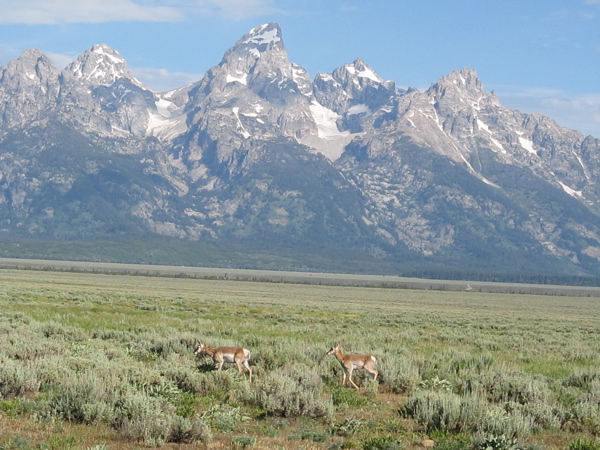Where the Deer and the Pronghorn Antelope Play…
Locally referred to as “antelope,” the pronghorn (Antilocapra americana), which lives in the plains and grasslands of North America, is often seen in the wide open spaces of Wyoming and is frequently observed by sightseeing tour visitors to Grand Teton and Yellowstone National Parks.
Like deer, pronghorns are even-toed ungulates (cloven hooved) mammals that eat grass, live in herds, and can run fast. (In fact, the pronghorn antelope is listed in the Guiness Book of World Records as the “Fastest Mammal on Land Over Long Distances.”)
 Unlike deer, pronghorn are diurnal (active during the daytime) and do not like to jump over fences, preferring instead to duck under a fence if they want to cross one. Pronghorn have branched, hollow, horns made from hair like cattle and goats, whereas deer and elk have branched, solid antlers. However, like deer and elk (and unlike cattle and goats), pronghorn shed their horns every year.
Unlike deer, pronghorn are diurnal (active during the daytime) and do not like to jump over fences, preferring instead to duck under a fence if they want to cross one. Pronghorn have branched, hollow, horns made from hair like cattle and goats, whereas deer and elk have branched, solid antlers. However, like deer and elk (and unlike cattle and goats), pronghorn shed their horns every year.
Pronghorn, like the American Bison, were once plentiful in the American West, ranging all the way from Canada to Mexico. Numbers of pronghorn declined from approximately 30-60 million in the early 1800’s to less than 15,000 by 1915. At one point, the pronghorn was in danger of extinction and they are still considered threatened or endangered.
The only members of the family Antelocapridae, pronghorn are not closely related to the Old World antelopes. However, the term antelope is used widely in Wyoming and other parts of North America – not only for the creature, but in place names. For example, Antelope Flats Road (off U.S. 191/89/26, about 2 mi north of Moose Junction) is a popular spot in Grand Teton National Park. In Yellowstone National Park, the Antelope Creek area (closed to human travel) offers refuge to grizzly bears.
Matt Fagan, Buffalo Roam Tours Guide
Read more facts on pronghorn antelope by the National Parks Conservation Association.
See photo gallery of pronghorn antelope in Yellowstone Park.
See Wikipedia entries on the North American pronghorn antelope vs. Old World antelope of Africa and Eurasia.


